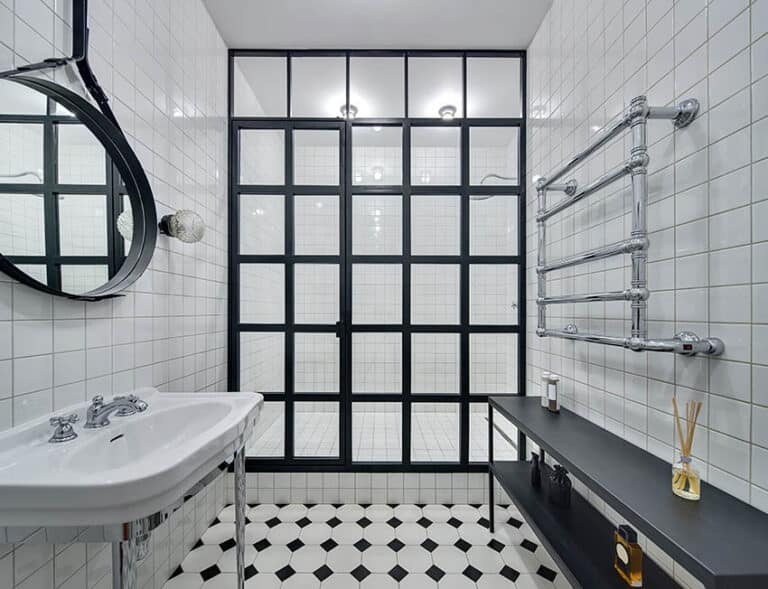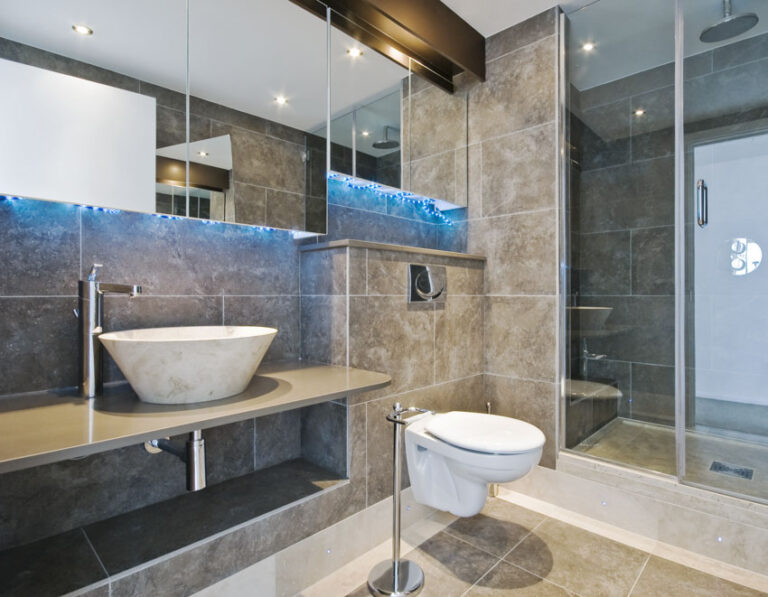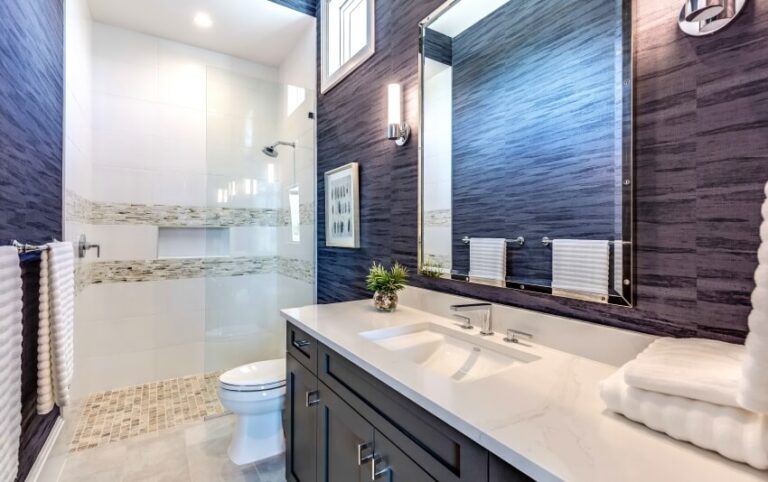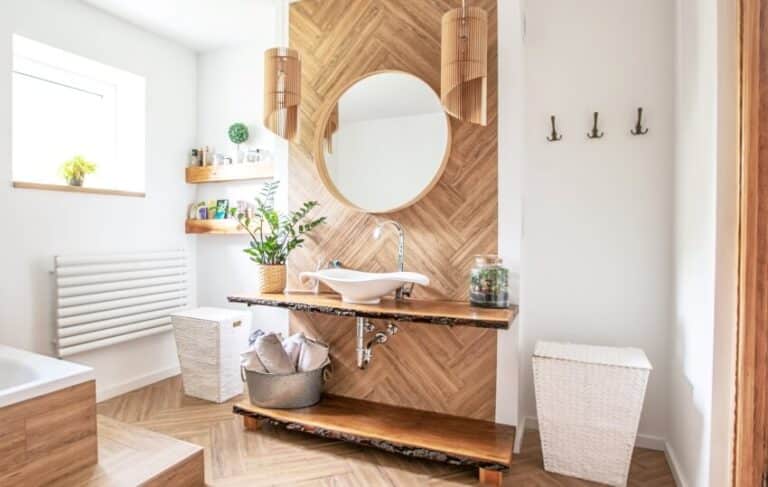Slate Shower Designs (Walls, Pans & Floor Ideas)
We’ve compiled a gallery of slate shower designs complete with their best features & attributes, cleaning tips, and shower ideas for walls, pans, and floors.
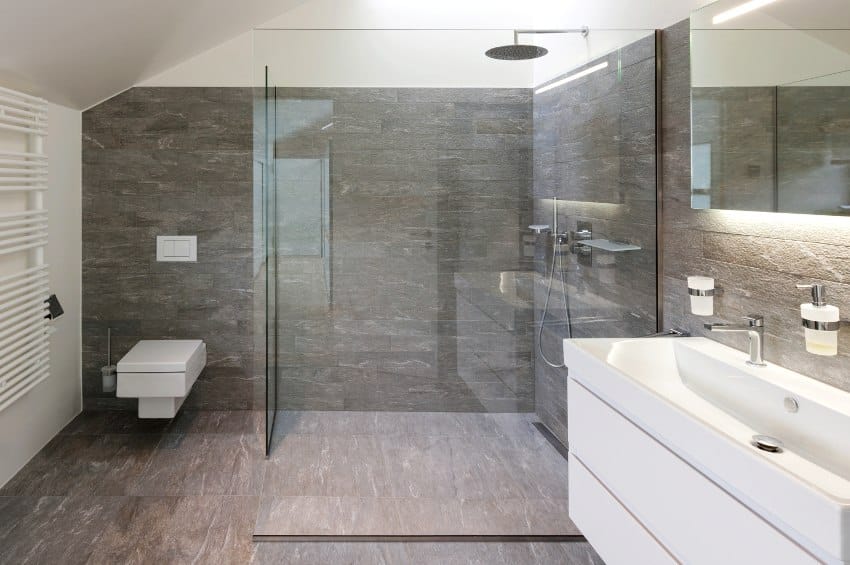
Whether opting for that sultry ambiance or aiming for that cool and moody personal space, a slate shower can bring that natural allure and texture to any bathroom style.
The classic and timeless quarried stone entered mainstream construction in the 18th century and has since been one of the more popular choices for finishing materials.
The wide range of possible slate shower designs due to the stone’s varied coloring makes the material versatile and customizable for any bathroom style.
Slate Tile Shower Attributes
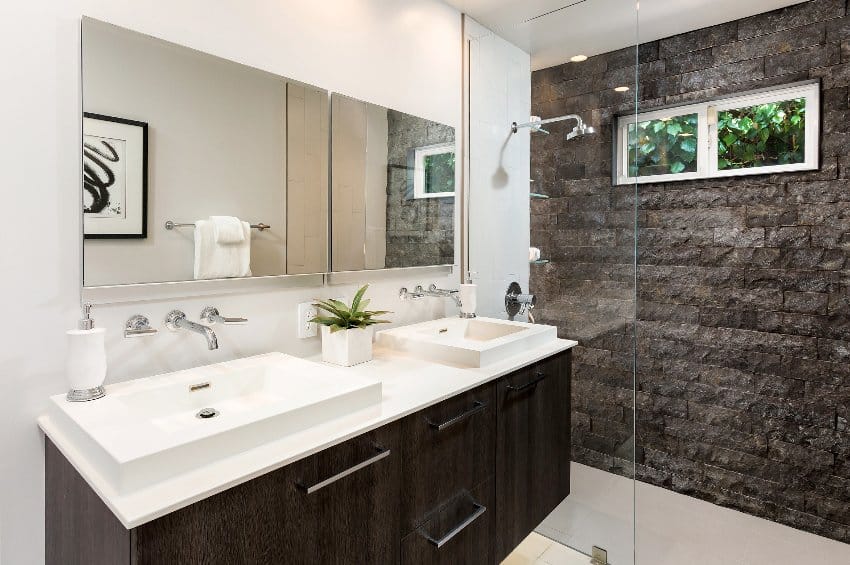
1. Stain Resistance – An Almost Impervious Surface. Many slate tiles have a natural surface texture that makes them slip-resistant, an important safety feature for slippery areas such as a walk-in shower.
Slate is stain-resistant because it is almost non-porous, meaning it has no tiny holes or pores that can absorb liquids or stains. Because of this, liquids and spills will sit on the surface rather than being absorbed into it, making it easy to wipe or mop up without leaving a stain.
Additionally, the stone’s density helps prevent staining because it is difficult for liquids to penetrate the tile’s surface.
Though, like any natural stone, it’s important to clean up any spills or stains as soon as possible to prevent them from setting in. Also, it’s recommended to seal the slate tile to enhance the stain resistance.
2. Resistant to Scratches and Dents– High Density. Subject to intense heat and pressure over time, the stone is composed of minerals with a structure naturally altered to withstand wear and tear.
3. Crack-Resistant – High Compressive Strength. In addition, with high compressive strength, it can support heavy loads without breaking or cracking. This makes it an ideal choice for the home’s flooring, countertops, and other high-traffic areas.
4. Slip-resistant – Natural Rough Texture. However, not all these stones have a naturally rough texture. Many of these stone materials are textured, which makes them slip-resistant, an important safety feature for all types of showers.
The reason is how the slate stone has been cut (cleft finish) and finished, making some stones more pronounced than others.
Moreover, the surface of these stone tiles usually comes in a matte finish, which helps to reduce glare and improve visibility. This can be beneficial in wet areas like showers and bathrooms, where glare can make the floor slippery.
5. Versatile – Varied Colors and Various Ribbons. Slate stone can be used not only in shower areas but also in different areas of the home, such as floors, walls, and even accent pieces. The bands of colors, textures, and composition (ribbons) also make it easy to mix and match with different aesthetic styles.
Ribbons in the stone refer to the natural layers or bands of color that run through the stone. These ribbons are formed when different minerals and elements are present in the rock as it forms, and they can give the surface its unique patterns and colors.
Some types of slate, like the ones from Vermont, are known for their striking ribbons of shades of green, purple, and red. These ribbons can add visual interest and character to surface texture as flooring, wall covering, or other architectural elements.
Ribbons can also affect the structural integrity of the stone; thinner ribbons may make the stone more fragile and prone to cracking.
Also, ribbons may affect how the stone can be cut and finished. Some ribbons may be more difficult to work with and require more skill and experience to cut and finish properly.
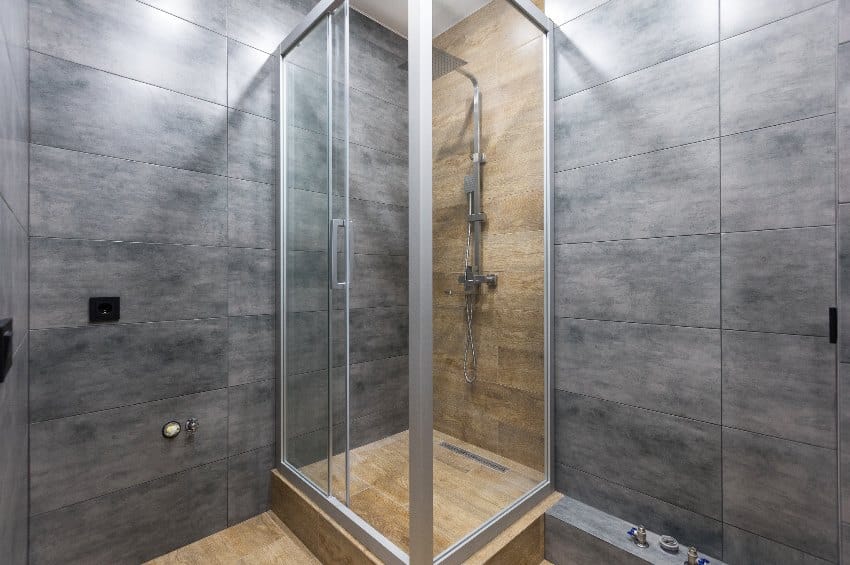
6. Affordable – Abundant Resource. Natural slate is not expensive because it is a relatively abundant and easily extracted natural resource.
Slate deposits can be found in many parts of the world, and the extraction process is relatively simple, making it a cost-effective material to produce. In addition, there are many manufacturers and suppliers of stone tiles, which results in a competitive market and lower prices for the consumer.
Take note, though, that the cost of natural slate can vary depending on the quality, color, and thickness.
Additionally, the location of the quarry and the cost of transportation can also affect the price. However, natural slate is generally considered a cost-effective option compared to other natural stone options.
7. Easy to Clean and Low-maintenance – Non-porous. As it won’t stain and discourages mold and mildew buildup, it is easier to clean and maintain this stone surface. The stone can also withstand most cleaning formulas, unlike other natural stones.
8. Weather Resistance – Stable Material Composition. The material is resistant to extreme temperatures and weather conditions, making it a suitable material for outdoor use.
9. Environmental-friendly – Abundance in Resources. The stone is a natural and sustainable material that is quarried and cut with minimal environmental impact.
Slate Clad Floors
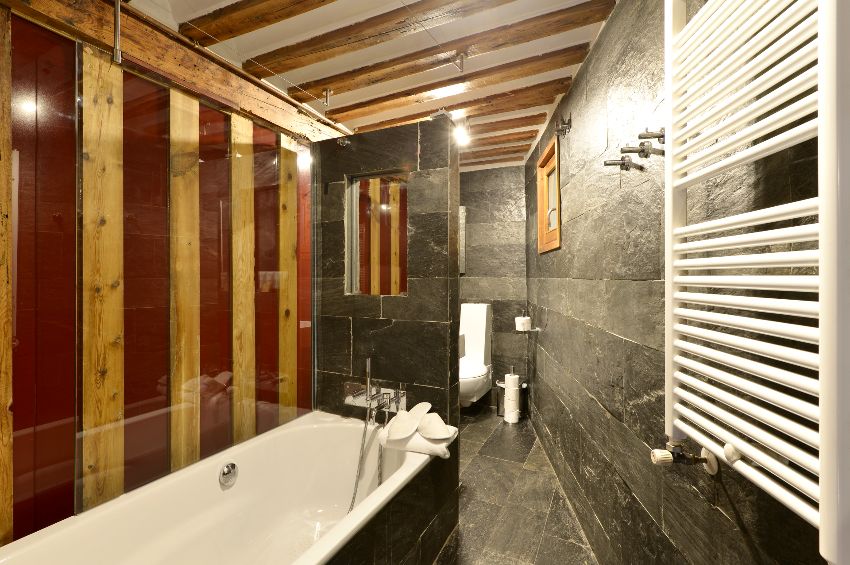
Slate shower floors are naturally durable, water-resistant, and slip-resistant. It is also considered a more hygienic choice as the non-porous surface is virtually water-resistant.
The organic touch varies in color, pattern, and thickness, making it easier to find the right stone shower design. Meanwhile, choosing a honed or cleft-finished slate for a shower floor is recommended to increase the slip resistance.
Some of the more popular slate shower designs for shower flooring are large format tiles. Using large-format stone tiles (12×24 inches or larger) has become increasingly popular.
This creates a sleek, modern look and can make a small space feel larger. Another option is using dark-colored stone. Black and dark grey colors are becoming more popular and can make a powerful statement in any interior bathroom.
Slate Mosaic Shower Pan
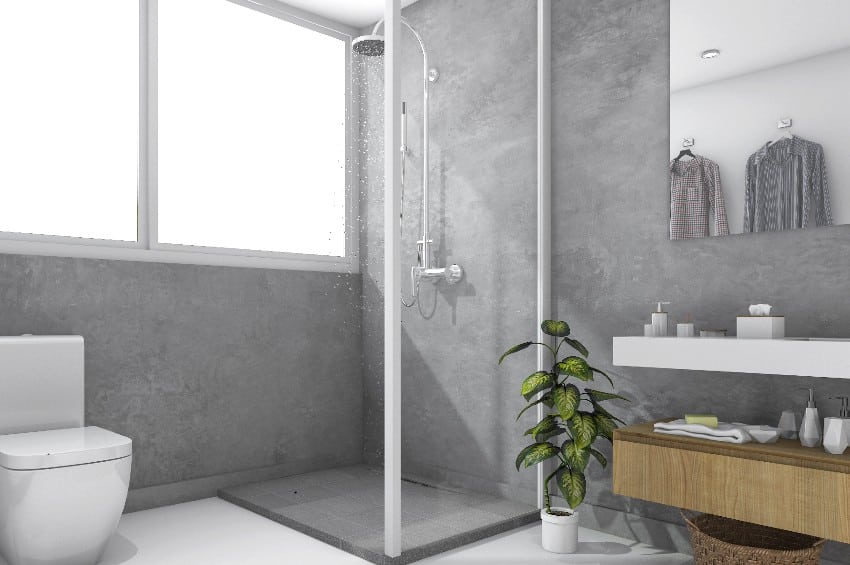
A slate shower pan is a great option for those who want to add a natural and elegant touch to their bathroom and have a durable and long-lasting shower base.
These shower pans can be custom-made to fit the dimensions of your shower and can be cut to any shape or size. They can be used with various shower enclosure types, such as glass enclosures, shower curtains, or shower doors.
Since these stones are slip-resistant and easy to clean, they make a perfect option as a shower pan to avoid slips and falls in the bathroom. However, as a natural quarried stone, slate can be a bit more expensive than other types of shower pans.
Slate Tiled Shower Walls
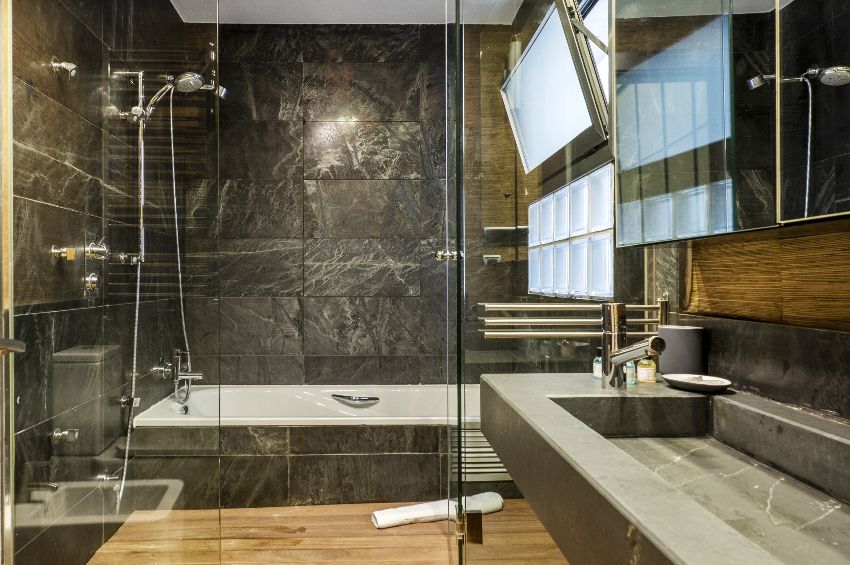
Slate stone walls can be designed in various ways to suit different design styles and preferences. Today, slate is a favorite material to create that spa-like effect in home bathrooms as it showcases that organic yet can maintain that luxurious ambiance.
Homeowners can use the usual modern tile patterns such as stack bond, hexagonal, or mosaic styles, but the stone tiles’ organic quality is usually showcased with natural split and random patterns.
A natural split pattern features a natural surface texture created by splitting the stone along its natural planes, creating a rough, irregular surface that provides excellent traction and slip resistance.
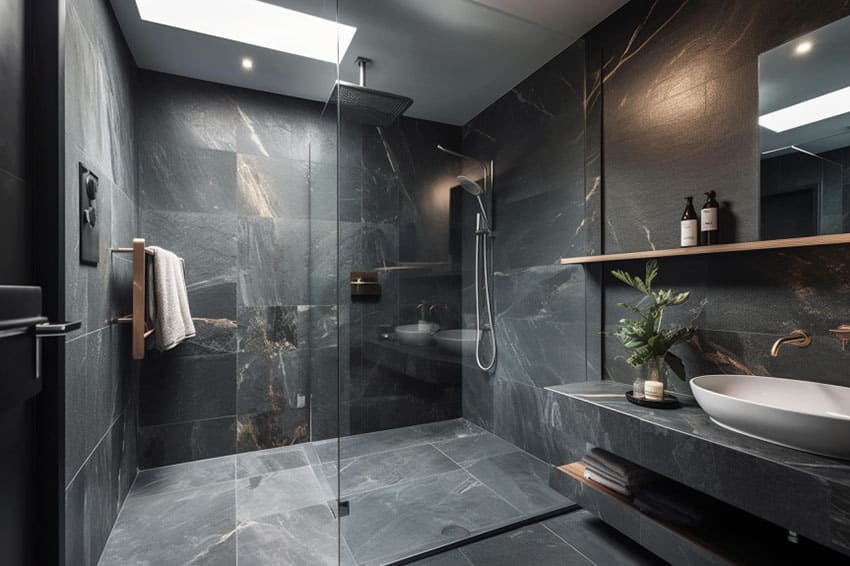
Another common slate shower wall design is in the honed finish, which comes in a smooth, matte finish that is created by grinding the surface of the stone to a smooth finish. This design is perfect for a contemporary or minimalist bathroom.
Sealing Natural Stone Tile Shower
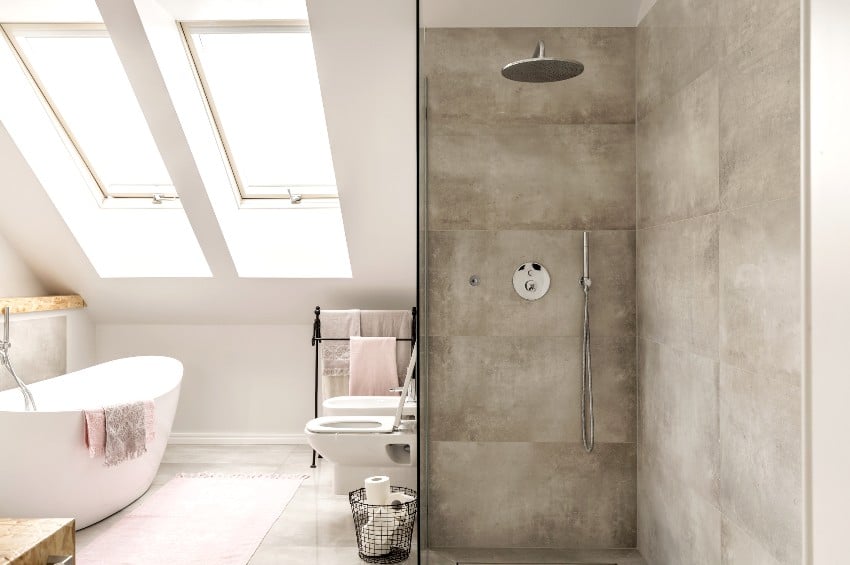
While slate tiles are virtually non-porous, efflorescence and other weathering conditions can accumulate over time and cover the natural color of the stones. Sealing also ensures that any cracks or issues from a possible faulty installation provide a protective layer to the shower area.
A penetrating sealer is typically the best on slate stone in a bathroom. These sealers penetrate the stone’s pores and create a barrier that repels water and other liquids. Water-based sealers are recommended for natural stones in general.
Please read the manufacturer’s instructions and test the sealer in an inconspicuous area before applying it to the entire bathroom. It’s also important to reapply the sealer every 1-2 years or as needed, depending on the usage.
How to Clean a Slate-Type Shower?
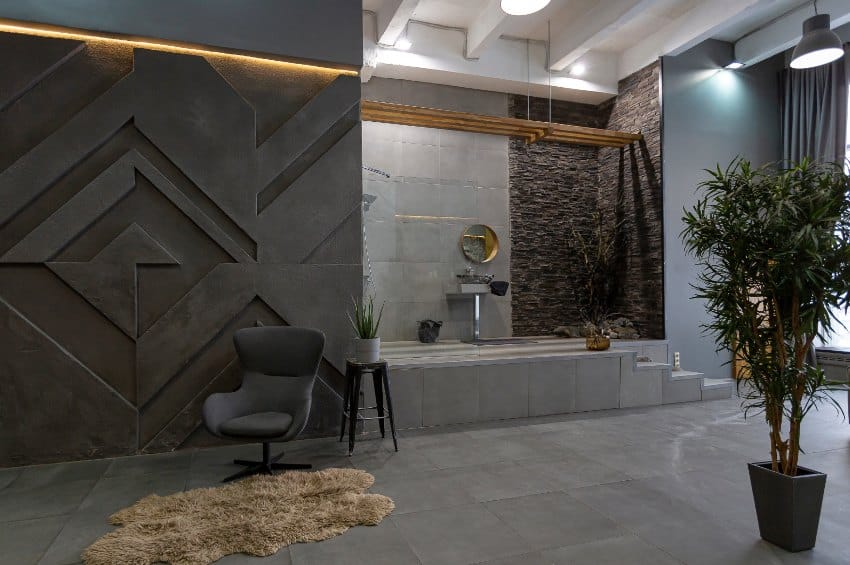
1. Sweep or vacuum the shower to remove any dirt or debris.
2. Mix a mild water cleaning solution and a pH-neutral cleaner or a specific cleaner for natural stone. Avoid using acidic or abrasive cleaners, which can damage the stone surface.
3. Apply the cleaning solution to the slate with a soft-bristled brush or a non-abrasive sponge. Scrub gently to remove any dirt or stains.
4. Rinse the surface thoroughly with water to remove any cleaning solution residue.
5. Dry the stone with a soft towel or a squeegee to prevent water spots.
6. Reapply the sealer if it is time for reapplication.
Textured slate tiles may require special care to maintain their unique texture and appearance. Use a stiff-bristled brush or a non-metallic scrubber to clean them, and avoid using acidic cleaners.
Always test a small, inconspicuous area before cleaning the entire surface to ensure that your chosen cleaning method and products will not cause any damage or discoloration.
How to Remove Soap Scum from Slate Panel Shower?
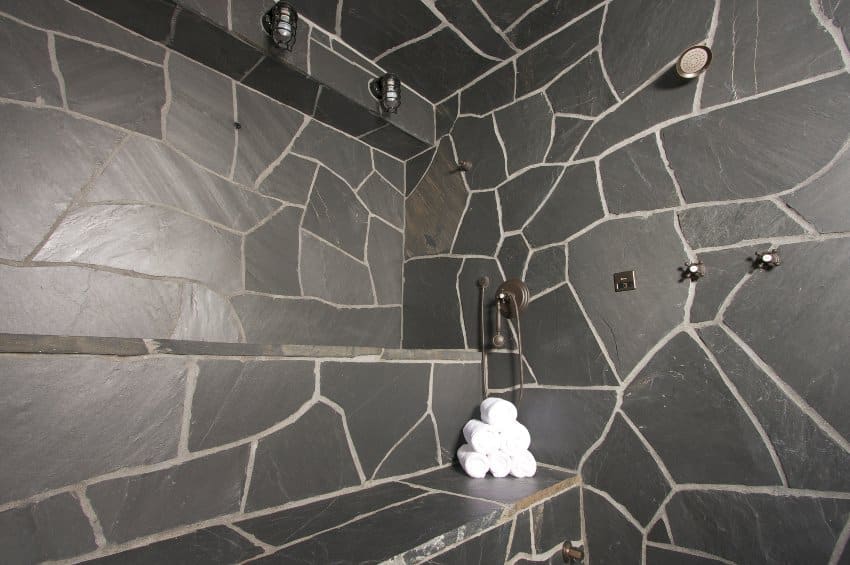
Soft Scrub. Mix baking soda and water paste and apply them to the soap buildup. Scrub gently with a soft-bristled brush or a non-abrasive sponge. Rinse thoroughly with water and dry with a soft towel or squeegee.
White Vinegar or Rubbing Alcohol. Mix equal parts white vinegar and water in a spray bottle. Spray the solution onto the soap buildup and let it sit for 15-20 minutes. Scrub gently with a soft-bristled brush or a non-abrasive sponge. Rinse thoroughly with water and dry with a soft towel or squeegee.
Lemon Juice. Mix equal parts lemon juice and water in a spray bottle. Spray the solution onto the soap buildup and let it sit for 15-20 minutes. Scrub gently with a soft-bristled brush or a non-abrasive sponge. Rinse thoroughly with water and dry with a soft towel or squeegee.
Commercial Cleaners. Commercial cleaners are also available specifically designed to remove soap scum and buildup from slate. Always read the manufacturer’s instructions and test the product in an inconspicuous area before using it in the entire bathroom.
Visit our slate bathroom floor tiles design guide for more bathroom interior ideas.

